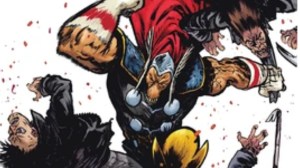We return to “Spider-Man’s Tangled Web” this week for a story that isn’t Christmas-themed, for a change around here. It does, however, feature a familiar artist who’s finally getting the popularity he’s always deserved: Lee Weeks.
Videos by ComicBook.com
Spider-Man’s Knowing Friend

The three issue story, titled “Gentlemen’s Agreement” across issues #7 – #9 was written by Bruce Jones, who also did a memorable run on “The Incredible Hulk” around that samw time in 2001 when this book was released. It features Charlie, a taxi cab drive who’s just been diagnosed with an inoperable brain tumor. A second doctor recommends an experimental procedure that would cost him $500,000.
Charlie has a secret. He knows that Peter Parker is Spider-Man. And now he faces a big question: Does he sell out Spider-Man to raise the money for the operation?
Jones is a magician in this story, for reasons I can’t get into here without spoiling everything. Suffice it to say, he uses the reader’s expectations and habits in reading comic book stories to his own advantage. I read the entire storyline while completely misunderstanding it, just because I drew a conclusion early on that was wrong.
That’s no mistake. That’s Jones’ game with this story. He’s using your knowledge of storytelling to take advantage of you. It’s very well done. It’s a bit confusing in the moment, but once you realize the mistake, it all makes sense.
Charlie is a very sympathetic character. He doesn’t want to do bad things. He’s struggling to come to grips with the questions he’s asking himself, even going as far as to a confessional for more vague advice to guide him. Ultimately, he tracks down a gang of criminals and makes a plan to get the money he needs, even knowing that it would come at a great cost.

(Suddenly, a Daredevil issue breaks out…)
Did he do the right thing? Can he be forgiven?
Spider-Man is a presence in this story without being an on-panel part of it. He doesn’t even appear until the third part. He’s kept mostly just off screen, a shadow swinging by at an opportune moment. This is a story told from the ground by a guy caught between a rock and a hard place. You’ll root for him even when you fear he’s making the wrong move.
The Art of Lee Weeks
Lee Weeks is my impetus for looking back at this book . His recent rise in popularity for his work at DC is just reminding people of how good he’s always been. This series may not have been his best, but it’s pretty darn good.
His storytelling is clear, with a restrained four tier panel layout. Sometimes it drops to three tiers, but for the most part every panel is squared off, with one clearly following the next. While Weeks does mix up the layout and presents some variations, he doesn’t get involved in gimmicks or bold choices that would make the original art more valuable while sacrificing the story.
He plays a lot, especially, with light in this story. In the repeated flashbacks to a car crash he was involved with, every panel is high contrast with a single point of super bright light. It might be the flash of the muzzle of the gun as the bullets are fired, the headlights of a car flipping over, or the street light shining down on Charlie as he slides out of his overturned taxi.

There are also random moments where he draws characters looking straight towards the reader and they have the most severe case of Rembrandt lighting I’ve ever seen. (That’s when you get the triangle of light on the cheek opposite the light source.) The characters look, at that point, like they’re drawn from people in real life, but that’s a minor distraction.
The characters are all unique and well defined and separated from each other. There’s never any confusion about one generic person looking like another.
It almost feels like a throwback form of storytelling. It’s almost sad that such straight forward and clean storytelling feels “old fashioned” when it should be the norm.
Josef Rubenstein is the inker, giving the art a final polish on the way to your eyes. His normal style is a little smoother than Week’s more angular nature, but the two combine well here. (Jimmy Palmiotti helps out on the third issue.)
Steve Buccellatto handles the coloring, giving the book a very ground level feeling. Tones are dark without any pastels or crazy bold colors. The brightest the colors ever get are the yellows used for headlights. He keeps the book feeling “real” without becoming murky or muddy.
Two Quick Things

Computer lettering was still relatively early on. Every time it’s used in signage, it stands out like a sore thumb. They’ve gotten better with that with computer lettering over the years, but in 2001, it was still clearly computer lettering pasted into the scene and it stood out like a sore thumb.
Bruce Jones wrote a lot of comics before 2001. He’s an “old school” writer. He knew how to start each issue off with a recap of the story so far via dialogue. It sticks out in 2018 because so few writers even bother anymore. They’re all “writing for the trade.” It is, however, fun to see the old technique in action.
Worth A Shot
“Gentleman’s Agreement” is a surprising story, even in a series that was known for its surprising takes on things. It’s the story of a dying man and what he’d do for his family, estranged though they may be. Jones pulls at just the right heart strings, using the emotions as an inciting agent, but not relying on them to carry the story. There’s one bit of business in the final pages that you’ll just have to accept as artistic license; don’t let it spoil the book for you.
Weeks’ art is great, and his cover work is particularly strong, with its heavily designed elements.
If you find this one in the quarter bins, jump at the chance….






![Simu Liu Confirms The 2 Dream X-Men Shang-Chi Works With On Avengers: Doomsday [Exclusive]](https://comicbook.com/wp-content/uploads/sites/4/2025/12/Simu-Liu-Avengers-Doomsday-interview.jpg?w=300)

